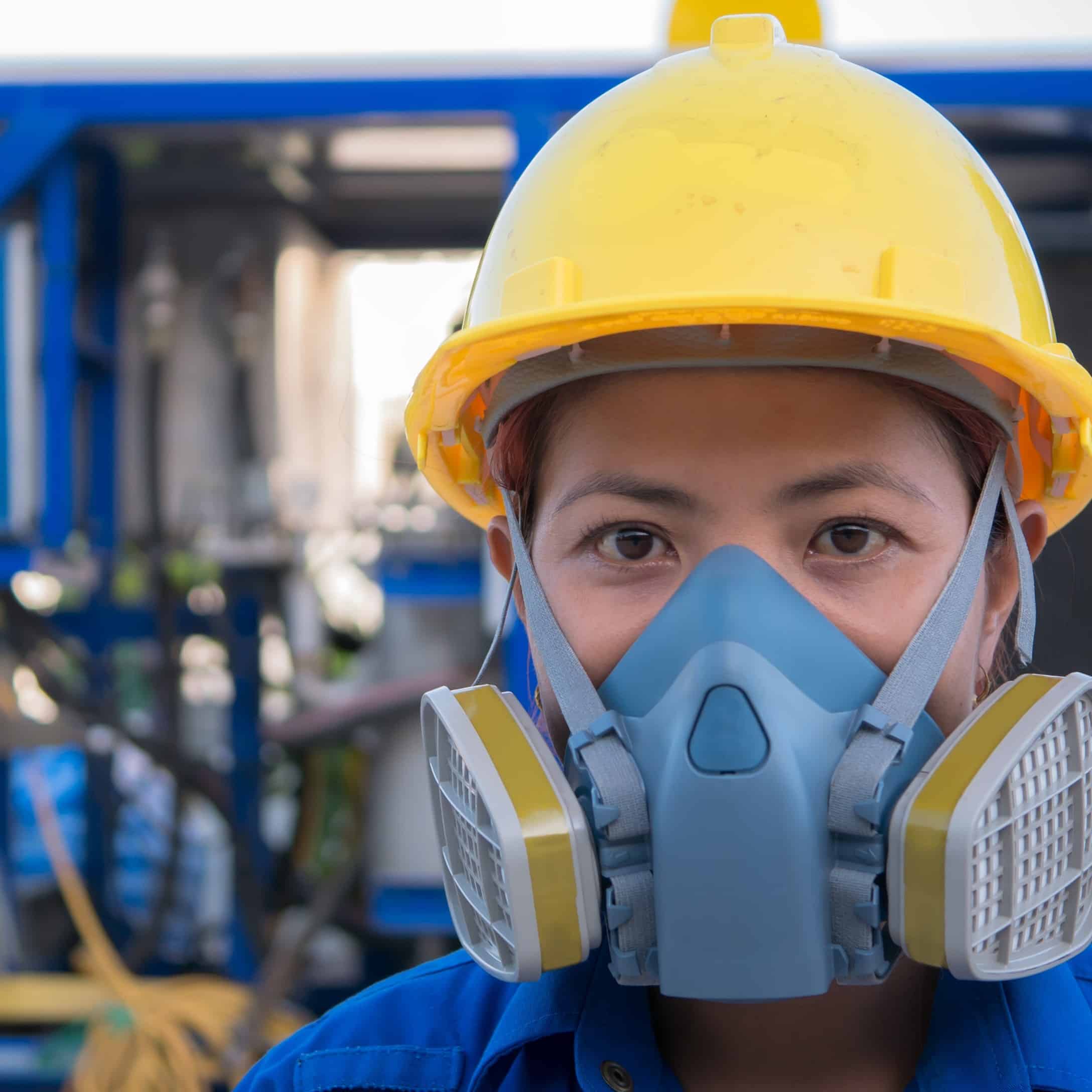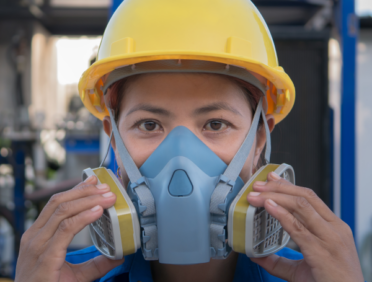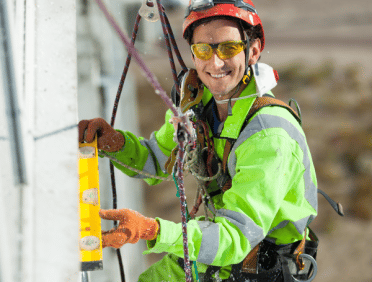Where asbestos is found?
Asbestos is a harmful building fabric that was used in a variety of construction projects before the year 2000. This includes those that are commercial as well as those that are residential. Whilst it is known to be harmful now, back then it was not the case, therefore this is why it is commonly seen used in buildings and is something that you may come across in your work.
Industrial property
- In industrial properties, asbestos may be found in ceilings, walls, beams or columns, all in the form of a sprayed coating.
- It may also be in loose-fill insulation and could even be there as an asbestos cement water tank.
- You can even find asbestos in lagging pipes and boilers, as well as some types of floor tiles.
Residential property
- In residential properties, it is common to find asbestos in pipes lagging throughout the house. It can also be a feature in loose-fill insulation too.
- It is often found in textured decorative coatings, such as artex and could be a feature in bath panels, partition walls and ceiling tiles too.
Why asbestos is dangerous?
As we have mentioned, asbestos can be incredibly harmful if you come into contact with it. This is because it can and does break down into thin fibres that are some fine that they can only be picked up on a microscope.
These fibres are so small that when they make their way into the air, they can remain airborne for many days.
Anyone who comes across these fibres may breathe them in, which means that they can then develop a scarring condition in their lungs. For the most part, this type of serious condition is usually only caused if you have long-term asbestos exposure.
If this does develop you may find that you have progressive shortness of breath, which can, over time, prove to be fatal.
Asbestos Legislation
To keep those people who could be in contact with asbestos safe, a publication entitled Managing and Working with Asbestos was created. Within this particular publication was the Control of Asbestos Regulations 2012.
These regulations came into force during April 2012 and they were there to update and replace the previous law that came into effect in 2006.
Part of the Act placed a duty on managing the regulations that are outlined within it. It also ensured that measures were taken to ensure that those who were exposed to asbestos were properly protected and that they were going to be kept as safe as possible.
Managing and working with asbestos
Managing and Working with Asbestos was created to be aimed at employers who may find their staff members are exposed to asbestos during their working lives, asbestos contractors who are experts in dealing with asbestos and also any other people, management or not, who are most at risk of asbestos exposure.
Some of the key aspects of this documentation are:
- How to identify whether asbestos is present and then determine the type and condition of the asbestos
- How to work safely with asbestos
- How to carry out risk assessments related to asbestos
It also has links to the relevant resources and legislation that relate to asbestos and can be used to keep those who are exposed to it, whether knowingly or not, safe.
Carry out a risk assessment
A key factor of asbestos safety is to ensure that a risk assessment is carried out. This must be completed before any work begins, and any results that come out of the risk assessment should be able to be dealt with before work needs to start.
The risk assessment is there to ensure that any risks that are associated with work are identified and that if any are found, that correct measures are put in place to control them.
The person who carries out the risk assessment must be someone who has a good level of knowledge, expertise and relevant training in the process. Having this means that they will be able to understand the key risk factors of asbestos and allow them to then make informed decisions that relate to risk and safety, as well as take the appropriate actions that are going to reduce the risk that it poses to workers.
During the risk assessment, they should:
- Establish the risk and who may be affected
- Identify what actions need to be taken to remove the risk, or to reduce the risk as much as possible if this is not possible
- Record any findings and the actions that have been, or are to be taken
They should then ensure that any actions are implemented, at that time. They will also be responsible for reviewing and updating the risk assessment as often as required.
The risk assessment needs to be suitable for the potential risk that asbestos poses. It should include full details of the work that is to be carried out and also how long the work is expected to take.
Other key aspects of the risk assessments are:
- Details of the quantity of the asbestos
- The condition of the asbestos
- The expected level of exposure
- Details of the controls that are going to be used to reduce exposure to asbestos whilst the work is being carried out
- What decontamination procedures are going to be carried out for the tools, the equipment and any PPE that is used
- How the waste products will be managed
- Any emergency procedures that can be carried out as needed
These risk assessments then need to be shared with anyone who could be impacted, especially employees, a copy should also be available on the site where the work is being carried out.
Click here to download a free risk assessment template.
You can take training on carrying out risk assessments here.
Licensed asbestos contractors
There are some businesses and employers that can be recognised as licensed asbestos contractors. These are licenses that are obtained via HSE and allow them to carry out licensable work with asbestos. This type of work is identified with Regulation 2 of the Control of Asbestos Regulations 2012.
Licensed contractors are recognised as:
- Those whose work with asbestos is not sporadic or low intensity
- That their risk assessment cannot demonstrate that their control limit will not be exceeded
- That they are working with asbestos coating
- That they are working with asbestos insulating board or asbestos insulation
If you carry out work that is recognised as being licensed is carried out without a license, then there is a chance that you may be prosecuted.
To apply for a license, you will need to go through HSE, they will ask you to complete an ASB1 form which is an application for the licence. You will also be asked to pay a fee. Once this is done, an inspector from HSE will formally assess you and will either grant your licence or advise you of key changes that you need to make for a licence to be approved.
Managing asbestos in buildings
Anyone responsible for the maintenance and repairs within a building should be aware of the key points of managing asbestos in buildings. This is because it is recognised that they must manage asbestos, as outlined in the Control of Asbestos Regulations 2012.
The people who could be seen as managing a building include:
- Owners of the building
- Those who are responsible via either a contract or a tenancy agreement
- That has recognised control of the building, even if no formal contract or agreement has been set out
About buildings, this applies to; all non-domestic buildings, the common areas of domestic buildings including halls, stairwells, lift shafts and roof spaces.
To properly manage asbestos in these settings, you will need to be aware of where it can be found, what impact it can have on people and of course what you need to control it and ensure that those who are exposed to it are as protected as possible.
Health and safety advice: Asbestos Awareness
To protect against the harmful effects of asbestos, it is important to have at least a basic understanding and awareness of asbestos. Particularly when it comes to health and safety. This advice can depend on what level of involvement and responsibility you may have within the building or business.
A building owner
The first thing to do is to identify whether or not asbestos is present and then determine the type of asbestos it is and the condition that it is in. If you cannot ascertain any of this initial information, then it is advisable to plan for the worst-case scenario to be as safe as possible.
Once you have done this, you may need to have someone who has the right level of knowledge of working with asbestos (if this is not you) carry out a risk assessment. They can identify what key areas of risk there are, then put together some ways that exposure can be avoided, or can be reduced.
You will then need to decide whether the work is licensable or not. If it is, then it will need to be carried out by a licensed contractor, if it is not licensable then you need to ensure that you have the appropriate control measures in place to ensure that everyone is safe.
It is your responsibility as the building owner, to ensure that anyone who is working with asbestos is suitably trained, has the right knowledge of what needs to happen and also has relevant equipment and tools to keep them as safe as possible.
Licensed contractor
If you are a licensed contractor working with asbestos, it is incredibly important to recognise the possible threats to health that asbestos can cause. Asbestos exposure can cause diseases that are not only severe but can even prove to be fatal too.
This means that even if you are a licensed contractor, you should try to only work with asbestos if it has been deemed to be necessary. Any work that is then carried out must always comply with the rules set out within the legislation and therefore should be strictly controlled.
Any work that is poorly controlled will then produce very high fibre levels, which can then cause issues for those who are exposed to it.
Asbestos medical examinations should be carried out when the exposure exceeds the recommended level, as this is when the highest chance of issues occurring can develop.
Anyone who is working with asbestos should have the appropriate level of training and knowledge and should be provided with protection to minimise the risk.
Member of the public
If you are a member of the public carrying out work on your property and you think that you have come across asbestos, then you should ensure that you stop carrying out your work immediately.
You should then take steps to confirm that this is definitely what the material is and have a risk assessment carried out.
Once you do this you will be able to identify not only whether or not it is asbestos, but also whether or not you will need to speak to a licensed contractor and organise them to work on the asbestos materials.
If it is deemed that the work that needs to be carried out is not licensable, then this does not mean that you can carry out the work without any knowledge. Even asbestos work that is not licensable should only be carried out by those that have the right level of training and the appropriate information that they need to keep safe too.
Tradesperson
There is always a chance that those who work as tradespeople are going to come into contact with asbestos in their everyday work. It is important that if this happens to you that you leave the asbestos materials alone and untouched. This even relates to materials that are only suspected to contain asbestos.
It is a good idea to be able to identify asbestos and asbestos materials, as a basic health and safety requirement. Especially since as a tradesperson, you can be put the most at risk. This means that asbestos awareness training could be a good idea for you. This will help you to understand what asbestos can do to you and how you should properly protect yourself.
Work with materials containing asbestos
There are a variety of materials that have been identified as possibly containing asbestos. These include:
- Loose asbestos in either floor cavities or ceilings
- Lagging
- Sprayed coatings found on ceilings, walls and beams
- Asbestos insulating board
- Textured coatings
- Asbestos cement
- Roofing felt
Once you know that these could contain asbestos, then you can be careful when working with them. Should you find asbestos, and then identify that it does not require a licence, then you can start to think about what to do when it comes to working safely with the materials.
You always want to be as cautious as possible and ensure that you have the right protective equipment to keep you as safe as possible.
Respiratory protective equipment (RPE)
To keep yourself safe from asbestos exposure, one of the most useful tools for you is going to be respiratory protective equipment or RPE. There are two main types of this; respirators and breathing apparatus.
Respirators are filtering devices which will filter out the contaminants when you breathe in. These could be powered respirators that use a motor to pass air through the filter, or non-powered respirators which then rely on the breathing of the wearer to draw air through the filter.
The breathing apparatus needs a supply of air that is of breathing quality that comes from an independent source. This could be an air cylinder or air compressor. These come in a variety of styles, this includes tight-fitting facepieces (these will often be identified as masks) and loose-fitting facepieces. These could be hoods, helmets, visors and suits too.
Training and providing information
To have the best chance of being safe against asbestos exposure, you want to ensure that you and those who may also fall into your duty of care, have the right training and information provided to them.
In many cases, the best protection that you can have against asbestos is simply knowing what to do and how best to protect yourself and those around you.
Asbestos Awareness Certificates
To show that you are aware of asbestos, its risks and how you can protect yourself and those around you, you can display an Asbestos Awareness Certificate.
You can take an Asbestos Awareness course (£17.50), gain a certificate and ensure your team are compliant by clicking here.
Alternatively, you can access our money saving bundles to save over 50% by taking two or more courses.












